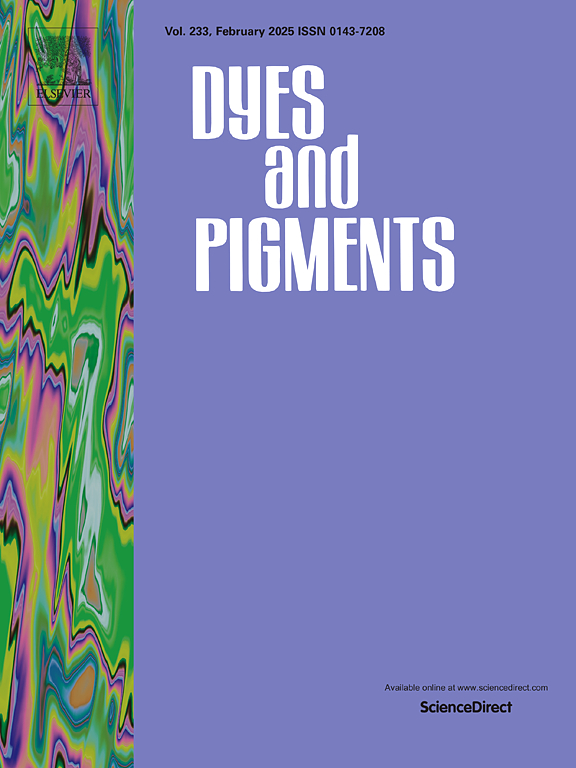Bis(triphenylamine) derivatives: Structure-dependent photophysical properties and electropolymerization ability
IF 4.1
3区 工程技术
Q2 CHEMISTRY, APPLIED
引用次数: 0
Abstract
The series of bis(triphenylamine)s consisting of different aromatic central cores has been designed and synthesized. This was done to test the dependence of the electrochemical properties and electropolymerization ability on the central core of bis(triphenylamine). It was observed that the compound containing a 1,3-substituted phenylene core most easily electropolymerize on the electrode surface, while dyes containing thiophene and EDOT cores do not undergo electropolymerization. This was further explained by DFT calculations of SOMO orbitals, which revealed that the amount of charge at the 4′ position of the phenyl rings of the triphenylamine group varies depending on the central aromatic core. Electrochromic properties of obtained polymers were also tested. The polymers containing electron-withdrawing groups change their color from red via brown to blue, while the polymers obtained via electropolymerization of phenylene derivatives exhibited colorless↔brown↔blue transition. Electrochromic parameters, such as color contrast, long-term stability, response times and coloration efficiency were also investigated. It was found that the electropolymerized layer of derivative with benzooxadiazole as a central core exhibited the best long term stability and it was able to switch between neutral and oxidized states over 700 cycles without loss in color contrast. It was also observed that the photophysical properties also depend on the central core of the dye. The compounds containing electron-withdrawing cores were found to exhibit solvatochromic properties, while the shift of the emission maxima with the solvent polarity was smaller for compounds containing phenylene groups and negligible for compounds containing thiophene and EDOT cores.

双(三苯胺)衍生物:结构依赖的光物理性质和电聚合能力
设计合成了由不同芳香族中心核组成的双(三苯胺)系列化合物。这样做是为了测试电化学性能和电聚合能力对二(三苯胺)中心核的依赖。结果表明,含有1,3取代苯基核心的化合物最容易在电极表面发生电聚合,而含有噻吩和EDOT核心的染料则不容易发生电聚合。SOMO轨道的DFT计算进一步解释了这一点,结果表明,三苯胺基苯环的4 '位置的电荷量取决于中心芳香核。还测试了所得聚合物的电致变色性能。含有吸电子基团的聚合物的颜色由红色经过棕色变为蓝色,而通过苯基衍生物电聚合得到的聚合物表现出无色↔棕色↔蓝色的转变。研究了电致变色参数,如颜色对比度、长期稳定性、响应时间和显色效率。结果表明,以苯并恶二唑为核心的电聚合衍生物具有较好的长期稳定性,可在中性和氧化态之间切换700次以上而不损失颜色对比度。还观察到染料的光物理性质也取决于染料的中心核。含吸电子核的化合物表现出溶剂致变色的性质,而含苯基的化合物的发射最大值随溶剂极性的变化较小,而含噻吩和EDOT核的化合物的发射最大值随溶剂极性的变化可以忽略不计。
本文章由计算机程序翻译,如有差异,请以英文原文为准。
求助全文
约1分钟内获得全文
求助全文
来源期刊

Dyes and Pigments
工程技术-材料科学:纺织
CiteScore
8.20
自引率
13.30%
发文量
933
审稿时长
33 days
期刊介绍:
Dyes and Pigments covers the scientific and technical aspects of the chemistry and physics of dyes, pigments and their intermediates. Emphasis is placed on the properties of the colouring matters themselves rather than on their applications or the system in which they may be applied.
Thus the journal accepts research and review papers on the synthesis of dyes, pigments and intermediates, their physical or chemical properties, e.g. spectroscopic, surface, solution or solid state characteristics, the physical aspects of their preparation, e.g. precipitation, nucleation and growth, crystal formation, liquid crystalline characteristics, their photochemical, ecological or biological properties and the relationship between colour and chemical constitution. However, papers are considered which deal with the more fundamental aspects of colourant application and of the interactions of colourants with substrates or media.
The journal will interest a wide variety of workers in a range of disciplines whose work involves dyes, pigments and their intermediates, and provides a platform for investigators with common interests but diverse fields of activity such as cosmetics, reprographics, dye and pigment synthesis, medical research, polymers, etc.
 求助内容:
求助内容: 应助结果提醒方式:
应助结果提醒方式:


